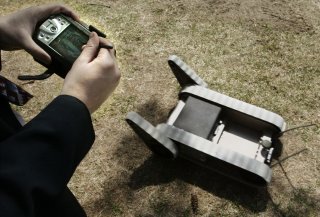by Kris Osborn

Movement to enemy contact, forward attack, amphibious operations, reconnaissance and scout tactics and defensive combat maneuvers were all missions performed by small Army robots engaged in mock-combat with dismounted infantry soldiers to replicate major warfare.
The experiment, known as a Soldier Operational Experiment (SOE), was conducted at Fort Benning, Georgia. Soldiers used four Light Robotic Combat Vehicle (LRCV) surrogates to perform combat operations in a range of great-power warfare scenarios. The idea, as explained in statements, was to give infantry the ability to perform high-risk missions both with and without the fleet of small robots to determine the impact of margin of difference the robots will make to a Rifle Platoon.
“The SOE re-enforced our idea that RCVs will not operate as a standalone system, but will provide new capabilities to an integrated fighting force,” said Major Cory Wallace, RCV lead for the Next Generation Combat Vehicles Cross-Functional Team.
The small robots, armed with sensors, weapons and networking technologies, were successful in many operations, yet did at times struggle to maneuver with dismounted infantry through certain kinds of rigorous or uneven terrain, the Army Futures Command statement said. These dynamics were an intended part of the process, as the idea was to gather soldier input on the RCVs with a mind to refining and improving the requirements and technologies for the platforms.
Wallace’s comment about the value of the robots being woven into the operational concept of integration and networking, meaning not functioning as a stand-alone system, speaks to the core essence of the Army’s modernization strategy which seeks to network otherwise disparate nodes of manned and unmanned systems across the force in real-time. As recently as November of this year, the Army performed yet another soldier experiment with unmanned systems, using air-drones, jammers, a “modular smoke obscuration module,” remotely operated M240 machine guns and Javelin anti-tank missiles.
“The RCV operators controlled the vehicles using the Warfighter Machine Interface integrated on dismounted operator control units. All of these capabilities correspond to some aspects of the draft requirements for future RCVs,” the Army statement said.
Not only does the Army seek to connect manned vehicles and command and control platforms to air and ground unmanned systems to one another, but the service is also increasingly working to advance multi-domain concepts of warfare. The SOE, which utilized the Light RCVs in what was called Project Origin, also demonstrated amphibious operations by having some of the robots “swim” across a pond to reach otherwise inaccessible areas.
Such a demonstration changes the tactical equation in that it could enable dismounted Army soldiers to send reconnaissance and even attack weapons over to the other side of a river, pond or body of water, all while being operated by humans performing command and control.
The next item on Project Origin’s agenda is to test how the vehicles could be integrated into the Opposing Force’s force structure at the Joint Readiness Training Center at Fort Polk, Louisiana, in summer 2021, the Army statement said.
No comments:
Post a Comment